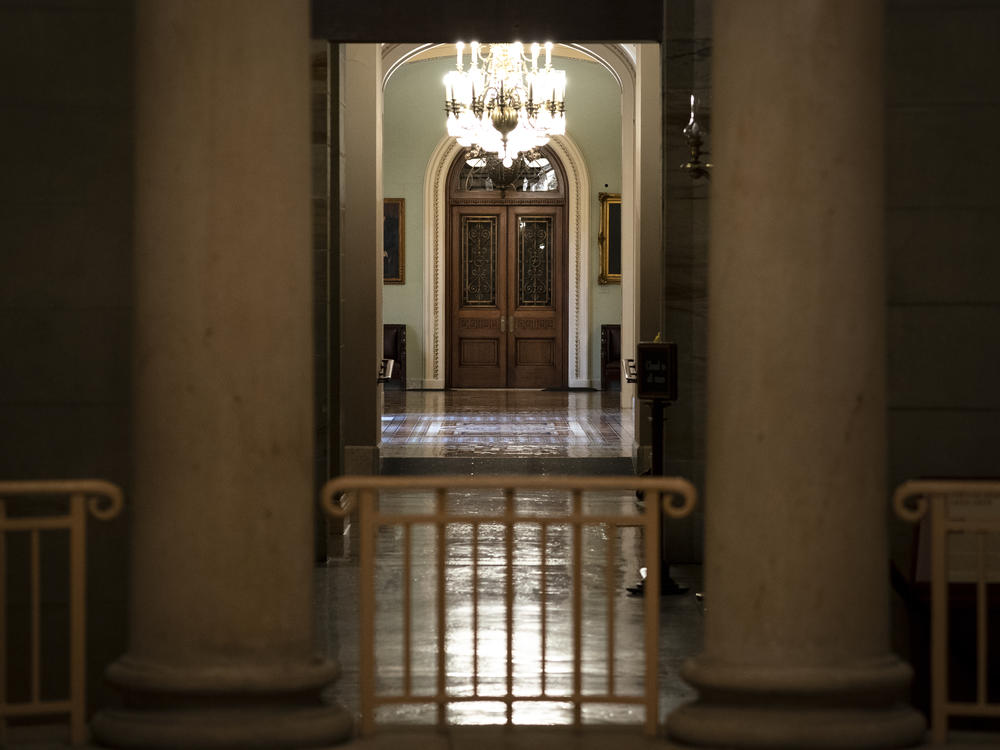Section Branding
Header Content
As Biden Aims To Pass 2 Big Bills, Things Are About To Get Really Complicated
Primary Content
In the days and weeks just ahead, the elected leaders of our federal government will perform a series of ritual dances that few Americans will understand.
You may turn away with a dismissive gesture or a rolling of the eyes. But these seemingly arcane exercises will, in fact, represent — and may even resolve — real conflicts over national issues of enormous importance.
At stake are the $1.2 trillion infrastructure package, trillions more in a spending plan for the next decade and even the degree of difficulty citizens will encounter when next they try to vote. The outcome will be a turning point for the Biden administration's first year in office and may have a powerful influence on the midterm elections looming in 2022.
Profoundly important as all these substantive matters are, much of the impending day-to-day debate and media coverage will use a kind of procedural and political code.
There will be much talk of the "Byrd Rule," mentions of a "carve-out" and possibly a "nuclear option."
Bear with us, because it's all about stuff that makes a difference.
The filibuster
Most of the focus will be on the Senate, where it takes 60 votes to break the tactic known as the filibuster before proceeding to any significant legislative action.
With the Senate parties evenly split, the challenge of getting 60 votes is next to impossible. It took months of exhausting negotiations to get the current infrastructure bill.
There is no chance of a similar compromise on President Biden's $3.5 trillion spending plan that covers a host of other priorities, which Republicans oppose. Yet without action on the bigger package in the Senate, Democrats in the House of Representatives probably can't hold their fragile majority together on infrastructure.
So, right now, Democrats are grinding through the infrastructure debate in the Senate with Republican help before leaving for August recess.
Reconciliation and the "Byrd Rule"
Step two would be to approve a budget resolution and trigger a process known as reconciliation, which has the very special feature of immunity to filibuster. With reconciliation as the vehicle, Democrats could prevail on their own votes alone, with Vice President Harris breaking the 50-50 tie.
But Democrats cannot simply load up reconciliation with anything they like, because the "Byrd Rule" allows any senator to object to any add-ons not related to the budget or reducing the deficit.
Overruling that point takes, you guessed it, 60 votes.
But let's back up and consider ...
How we got here
During the 93rd Congress (1973 to 1974), the House and Senate were busy bringing down President Richard Nixon. In addition to the impeachment process that would force Nixon to resign, Congress passed two landmark laws to limit his powers over the military and federal spending. Presidents have had to live with those laws ever since.
Among those engineering the War Powers Act and the Budget and Impoundment Control Act was the second-ranking Democrat in the Senate, Majority Whip Robert C. Byrd of West Virginia.
Then in his third term, Byrd had first been elected in 1958 and would be reelected eight times before his death in 2010. He remains the longest-serving senator in history.
But back in 1974, Byrd was among those convinced that Congress needed to reassert itself after letting presidents wage undeclared war in Vietnam and re-engineer domestic spending through the White House Office of Management and Budget.
Byrd supported the creation of standing budget committees in the House and Senate along with a Congressional Budget Office. There would be a congressional "budget resolution" to guide changes to revenue and spending, and a procedure to reconcile each year's changes with existing appropriations law.
The Senate's provision for extended debate, commonly known as the filibuster, had long been used to delay bills to death. So the Budget Act provided that, if necessary, the reconciliation bill would come to a floor vote in the Senate with no more than 20 hours of debate.
Without the threat of a filibuster, final passage needed only a simple majority. Like other Democrats at the time, Byrd hoped this would make Congress more agile in its struggles with the executive.
Along came Reagan
Reconciliation was not a big deal in its first years of existence, but it was brought to prominence after 1980 when newly elected President Ronald Reagan brought a new Republican majority to the Senate.
Reagan and Co. used reconciliation in their first budget season to slash taxes and domestic programs while increasing spending for defense, and Democrats who opposed the changes could not filibuster them in the Senate. (They passed in the House with the votes of Republicans and conservative Democrats, mostly from the South.)
This use of reconciliation continued through Reagan's first term, and Senate Republicans used it for nonbudget items such as the size of federal commissions. At that point, Byrd rebelled and led a group of senators opposed to what he called "extraneous" provisions.
First used in 1985, and made permanent in 1990, the Byrd Rule allowed for any senator to raise a point of order against anything in reconciliation that was deemed extraneous. Defining extraneous was up to the Senate's presiding officer in consultation with the Senate parliamentarian.
That definition, or the point of order itself, could only be overruled by a 60-vote supermajority. So, while not directly related to the filibuster, the Byrd Rule had the effect of restoring the Senate's 60-vote threshold for legislative success on nonbudget measures.
Voting rights may not qualify in reconciliation bill
Most of what has been proposed for this year's reconciliation process, including the framework of Biden's $3.5 trillion spending plan, would be described as relevant to revenues and spending.
But advocates have urged that other urgent Democratic priorities be folded in, such as the voting rights protection bill known as the For the People Act.
Republicans who filibustered the legislation as a stand-alone bill this summer would surely raise a point of order against its inclusion in reconciliation.
Democrats would be hard-pressed to find the 10 votes from across the aisle they would need to prevail, at least as the bill is written now. Anything that passed muster with Democrats would be difficult to sell across the aisle in the current climate.
The "carve-out" option
In recent weeks, as the battle lines have hardened on the voting rights issue, some Democrats have argued for another route around the 60-vote obstacle.
House Majority Whip James Clyburn, a South Carolina Democrat, has suggested a "carve-out" might be created to enable this specific piece of legislation to reach the floor and ultimately become law.
Clyburn, who played a key role in Biden's primary campaign and nomination in 2020, has urged the president to press for an exception to current Senate rules.
"My dad used to say to me: 'Anything that's happened before can happen again,' " Clyburn said, pointing to past exceptions and exhorting Biden to "call Joe Manchin."
Manchin is the West Virginia Democrat elected to the Senate when Byrd died. Often seen as the most conservative Democrat in Congress, Manchin has repeatedly defended the filibuster as a guarantee of "involvement of the minority."
This week, Manchin said he does not support a "carve-out" as proposed by Clyburn.
Ending the filibuster?
One big exception to the filibuster is, of course, reconciliation itself. But the 1974 act sailed through Senate final passage without any nay votes and was in no danger of being filibustered. That is not true of the voting rights legislation today, which was stopped by a filibuster threat earlier this summer.
As an alternative, Clyburn has suggested the Senate could use the same procedure again that it used in 2013 when Nevada Democrat Harry Reid was the Senate majority leader. Frustrated by Republicans who had threatened to filibuster more than 100 nominations to executive positions during then-President Barack Obama's second term, Reid used his majority to "establish a new precedent."
Reid's new precedent in essence barred filibusters on the confirmation of presidential appointees. It made an exception for Supreme Court nominees. But that exception was removed four years later when Republicans were in the majority and their leader, Mitch McConnell, extended Reid's precedent to include the Supreme Court. It was no accident that all three of former President Donald Trump's appointees to the high court were confirmed under this precedent.
So why not another "new precedent" for voting rights? It could happen, in theory, but it faces a far higher hurdle. Because, unlike the Reid and McConnell precedents, the "Clyburn carve-out" would enable passage of a piece of legislation.
"Any such exception would be a very unstable equilibrium and a first step down a quick road to full filibuster abolition," said Molly Reynolds, senior fellow in governance studies at the Brookings Institution.
It would be the end of the filibuster — not just "as we know it," but period.
That was the Rubicon both Reid and McConnell explicitly refused to cross and promised not to cross. It has also been called, in a more modern metaphor, the "nuclear option." No leader to date has pushed a vote on this, in part, because none could be sure of the support of all his own party members.
After all, the Senate is still the Senate. Its rules and customs are rooted in its origins as a 26-member club with no political parties and a penchant for individualism.
At a glacial pace, the chamber has inched toward simple majority rule. Cloture was established in 1917, creating a means for cutting off debate, and cloture got easier with the lower vote requirement in 1975.
But that led to increased use of — and indeed an almost casual reliance on — the threat to filibuster. So instead of one or two filibusters a year on average (1917-1970), the number of cloture votes per year has skyrocketed off the charts — averaging more than 80 per year since 2010.
Senators threaten filibusters on virtually anything requiring a vote, and the 60-vote threshold has all but become the chamber's defining feature.
No public vote has been taken on the question, but whichever party is in the minority can be assumed to oppose eliminating the filibuster. And at the present moment, Manchin is far from the only Democrat with doubts.
Life in the Senate without the filibuster would be much like life in the House, only with longer terms and much higher fundraising requirements.
Making them talk
Biden this summer has said the solution is to make the filibustering senators talk until they collapse, as was the custom in the 1950s and 1960s.
"People finally got tired of the talking and collapsing, and you could get a quorum and vote on the bill," Biden said.
That was the pressure, both physical and in terms of media and public attention, that finally brought the filibusters against civil rights legislation to an end, especially since C-SPAN began broadcasting Senate proceedings in 1985.
In the last half century, the threat to filibuster (sometimes called a virtual or silent filibuster) has proven a more durable and effective weapon. Television came to the Senate in the 1980s, and since then senators have used their right to extended debate occasionally to give what Sen. Bernie Sanders of Vermont has called "very long speeches."
But when Republicans such as Ted Cruz of Texas or Rand Paul of Kentucky have gone on for hours, it has been for the purpose of calling attention to something or someone.
Biden's suggestion, which has been made by others over the years, would be to require extended debate be done live and in color on the floor of the Senate for as many days and nights as necessary.
That might well bring the Senate to a full halt for months, but at least it would make clear who was responsible.
Copyright 2021 NPR. To see more, visit https://www.npr.org.



